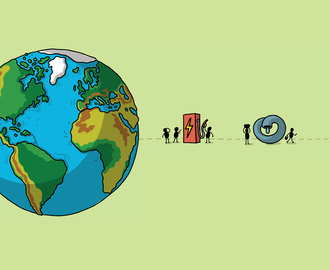Credit: posteriori / Shutterstock
What you’ll learn:
- Companies and startups must now weigh geopolitical risk alongside technological opportunity.
- Supply chains have lately proved to be fragile, with critical inputs often controlled by China or Russia. Firms should prioritize resilience over speed.
- Innovation ecosystems can support innovation, but reliance on production in other locations for industrialization and scaling can lead to vulnerabilities.
Geopolitics has moved from government ministries into the boardroom. Tariffs, sanctions, export controls, and industrial policies now shape how companies choose markets, build supply chains, and even hire talent.
This new reality has made geopolitics a central factor in innovation, pushing companies and startups to weigh political and policy risk alongside technological opportunity, said Fiona Murray, associate dean of innovation at MIT Sloan and a professor of entrepreneurship.
“Geopolitics has to be on the agenda in every boardroom, every investment committee, and every startup accelerator,” Murray said in a Leading Edge webinar organized by MIT Corporate Relations and moderated by senior lecturer Phil Budden, with whom Murray co-authored the 2025 book “Accelerating Innovation: Competitive Advantage Through Ecosystem Engagement.”
“For the last 35-odd years, people, especially in the West … were able to separate out geopolitics from economics. But now in 2025, it’s on everybody’s agenda,” Budden said.
Murray outlined the forces driving innovation today and their implications for corporations and startups alike.
Investment, Startup Ecosystems and Geopolitical Calculus
What innovators need to know
Geopolitics is reshaping the fundamentals of innovation in four ways that business leaders should be aware of, Murray said:
- The world is no longer flat. In 2005, journalist Thomas Friedman declared that “the world is flat,” arguing that globalization had erased barriers to trade, talent, and ideas. That tenet no longer holds, Murray said. “By 2025, for innovation, it’s not flat,” she said. “It’s highly concentrated in places that we call innovation ecosystems.” Those include the traditional powerhouses, like Silicon Valley and Boston, as well as newer hot spots, like London and Munich. At the same time, manufacturing and supply chains are concentrated in places like Shenzhen, China.
- The U.S. and China have entered a period of competition, facing off as adversaries but also as peers in technology for the first time in recent history. Murray pointed to the extraordinary surge in the number of patents filed by Chinese companies, plus the nation’s advances in areas like battery storage, hydrogen power, fusion, and quantum as evidence of China’s rise.
- Economic statecraft has become pervasive in countries around the world, Murray said. Tools such as export controls, tariffs on imports, and investment restrictions no longer apply solely to the defense industry. In fact, they are now used by governments to shape industries, whether life sciences, semiconductors, or quantum computing.
- The energy transition, especially, has become geopolitical. Starting from rare earth minerals through to the semiconductors, turbines, and batteries that rely on them, supply chains underpin our advances in energy, mobility, and even artificial intelligence. The countries that control metals extraction and processing hold significant leverage over global supply chains. Murray argued that innovation is needed to develop cleaner ways of extracting and processing them — backed by real investment.

Innovation Executive Academy
In person at MIT Sloan
Register Now
Action items
Given those fundamentals, Murray and Budden offered the following advice to business strategists in global companies:
Build a geopolitical calculus into your strategy. For decades, many corporate leaders assumed that geopolitics and economics could be kept apart. That separation is no longer possible. “We need a new geopolitical calculus through which to make our decisions around innovation, industrialization, and investment,” Murray said.
Secure and diversify your supply chains. Supply chains are fragile, as the war in Ukraine has proved. Murray explained how the country could not secure all the drones it needed because “every single one of the components could only be sourced at scale in China.” Other critical inputs, such as rare earths and superconducting magnets (needed for fusion energy) are vulnerable to choke points because their availability is often controlled by China or Russia — underlining the importance of diversification in supply.
Respond to industrial policy and statecraft. Governments are reasserting themselves as industrial actors. NATO’s 1 billion euro Innovation Fund, for instance, uses capital from 24 member nations to back startups developing deep-tech and dual-use technologies for defense, security, and resilience. Governments are using industrial policy to support strategic industries in many new ways while also imposing controls on trade and investment — a reminder, Murray said, that statecraft can both support and constrain corporate strategy while also building new market opportunities.
Guard against adversarial capital. Investors aligned with adversarial states are an emerging risk, especially for early-stage companies struggling to access capital from traditional sources. Murray warned that financial vulnerability is “often the moment when adversarial capital comes in.” Governments and allied investors are increasingly focused on protecting startups from such threats — which underscores the importance of working with trusted partners and funds that understand the security implications of frontier technologies.
Use ecosystem advantage wisely. The physical location where companies anchor their early-stage innovation and their later-stage scaling shapes opportunity and risk. Boston, for instance, has become a global life sciences hub and home to many early-stage ventures — yet much production is scaled abroad, including in China. “This globalized industrial logic is suddenly coming into question, and we’re having to start to really think about how we reshore production back to the U.S. and partners,” Murray said. For companies, innovation ecosystems offer advantages, but reliance on the industrial base for production in rival countries can create vulnerabilities.
Stake out an early lead in emerging technologies. Murray noted that “the race is on, particularly with China,” when it comes to next-generation technologies like advanced batteries and quantum computing. She also highlighted how European nations are seeking advantage in post-quantum encryption, fusion energy, and rare earth processing as critical areas of government interest. For companies, the implication is that leadership in these fields will shape long-term advantage in the years to come if built with resilience in mind.
Innovate with your eyes open
Geopolitics and innovation can no longer be separated, Murray concluded, acknowledging that decisions on technology, industry, and investment are being made in a period of unprecedented uncertainty — when supply chains can be disrupted and capital flows restricted, and leadership in new technologies is up for grabs.
For established companies and startups alike, the stakes are now bigger than profits. In an era of great-power rivalry, the ability to innovate is tied directly to national resilience and security itself.
Dame Fiona Murray is an international policy expert on the transformation of investments in science and technology into deep-tech startup ventures that solve significant global challenges and create national advantage. She is the associate dean of innovation at MIT Sloan, a professor of entrepreneurship, and faculty director of the MIT Kuo Sharper Center for Prosperity and Entrepreneurship. Murray also is chair of the NATO Innovation Fund and was awarded a Dame Commander of St. Michael and St. George for her services to U.K. innovation and entrepreneurship.
Phil Budden is a senior lecturer at MIT Sloan. He combines academic, historical, and real-world perspectives to determine how different stakeholders — including entrepreneurs, universities, risk capital providers, corporate enterprises, and government policymakers — contribute to building successful innovation ecosystems.
Together, Murray and Budden are co-authors of “Accelerating Innovation: Competitive Advantage Through Ecosystem Engagement” (MIT Press, 2025).




